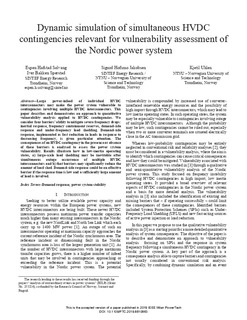| dc.contributor.author | Solvang, Espen Hafstad | |
| dc.contributor.author | Sperstad, Iver Bakken | |
| dc.contributor.author | Jakobsen, Sigurd Hofsmo | |
| dc.contributor.author | Uhlen, Kjetil | |
| dc.date.accessioned | 2019-09-06T06:51:22Z | |
| dc.date.available | 2019-09-06T06:51:22Z | |
| dc.date.created | 2019-09-05T09:26:17Z | |
| dc.date.issued | 2019 | |
| dc.identifier.isbn | 978-1-5386-4722-6 | |
| dc.identifier.uri | http://hdl.handle.net/11250/2612844 | |
| dc.description.abstract | Large power-infeed of individual HVDC interconnectors may make the power system vulnerable to contingencies involving multiple HVDC interconnectors. This paper describes and demonstrates an approach to quantitative vulnerability analysis applied to HVDC contingencies. We consider four barriers' ability to mitigate severe frequency drops: inertial response, frequency containment reserves, demand-side response and under-frequency load shedding. Demand-side response, implemented as fast reduction in loads in response to decreasing frequency, is given particular attention. The consequences of an HVDC contingency in the presence or absence of these barriers is analysed to assess the power system vulnerability. Results illustrate how in low-inertia operating states, a) large-scale load shedding may be inevitable after simultaneous outage occurrence of multiple HVDC interconnectors and b) that barriers may significantly reduce the amount of load shed. Demand-side response could be an effective barrier if the response time is low and a sufficiently large amount of load is involved. | nb_NO |
| dc.language.iso | eng | nb_NO |
| dc.publisher | Institute of Electrical and Electronics Engineers (IEEE) | nb_NO |
| dc.relation.ispartof | 2019 IEEE Milan PowerTech | |
| dc.title | Dynamic simulation of simultaneous HVDC contingencies relevant for vulnerability assessment of the nordic power system | nb_NO |
| dc.type | Chapter | nb_NO |
| dc.description.version | acceptedVersion | nb_NO |
| dc.identifier.doi | 10.1109/PTC.2019.8810863 | |
| dc.identifier.cristin | 1721745 | |
| dc.relation.project | Norges forskningsråd: 255226 | nb_NO |
| dc.description.localcode | © 2019 IEEE. Personal use of this material is permitted. Permission from IEEE must be obtained for all other uses, in any current or future media, including reprinting/republishing this material for advertising or promotional purposes, creating new collective works, for resale or redistribution to servers or lists, or reuse of any copyrighted component of this work in other works. | nb_NO |
| cristin.unitcode | 194,63,20,0 | |
| cristin.unitname | Institutt for elkraftteknikk | |
| cristin.ispublished | true | |
| cristin.fulltext | postprint | |
| cristin.qualitycode | 1 | |
